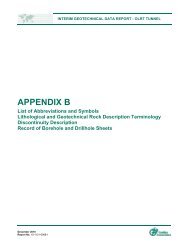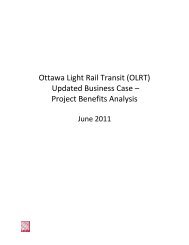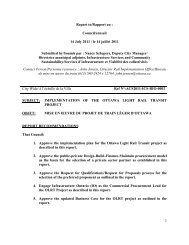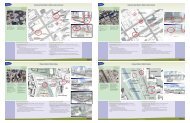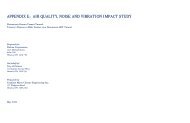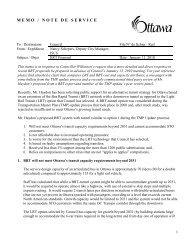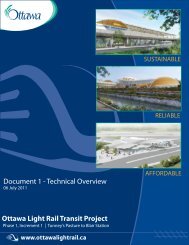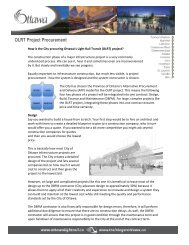Transportation Master Plan - Ottawa Confederation Line
Transportation Master Plan - Ottawa Confederation Line
Transportation Master Plan - Ottawa Confederation Line
Create successful ePaper yourself
Turn your PDF publications into a flip-book with our unique Google optimized e-Paper software.
Element 2:<br />
Principles:<br />
Meet mobility needs<br />
a) Provide a continuous, integrated system of multimodal facilities and<br />
services<br />
b) Aim to provide an acceptable standard of service for each mode of travel<br />
c) Give priority to public transit, walking and cycling over cars when<br />
conflicts arise<br />
d) Provide barrier free transportation facilities and services<br />
Reducing travel delays to people and goods will remain a key goal in 2031. Travel by bus, light<br />
rail and car will be reasonably direct and fast, with quality connections to walking and cycling<br />
networks. Goods will move efficiently. Persons with disabilities will not encounter barriers that<br />
restrict access to key destinations. To achieve these goals, the City will have provided new<br />
infrastructure and services that encourage desired changes in behaviour and prevent unacceptable<br />
levels of congestion and delay, neighbourhood traffic infiltration and air pollution. Transit system<br />
capacity will have increased substantially to keep pace with a rising population and growth in<br />
transit modal split. Despite a reduction the automobile’s modal share, road capacity will also have<br />
increased in an effort to preserve minimum acceptable service levels for traffic.<br />
Element 3:<br />
Principles:<br />
Integrate transportation and land use<br />
a) Build walkable communities<br />
b) Provide rapid transit and other quality transit services to community<br />
cores and employment areas<br />
c) Foster transit-oriented development in transit nodes and corridors<br />
d) Support intensification where transit, walking and cycling can be made<br />
most attractive<br />
e) Foster a vibrant downtown by improving transit, walking and cycling<br />
access<br />
f) Recognize the distinct transportation needs of rural communities<br />
By 2031, walkability will be the firmly established foundation of urban sustainability, with<br />
benefits ranging from health to equity, environment and the economy. Community design will<br />
revolve around pedestrian access to transit, especially rapid transit services that offer fast and<br />
reliable links between communities and employment centres. Transit will be supported through a<br />
consistent approach to development location, mix, density and site design that makes<br />
intensification a benefit for quality of life, rather than a burden. While transportation facilities<br />
such as sidewalks, pathways, rapid transit lines and roads will enable travel, they will also serve<br />
as public spaces and enliven communities through design that is sensitive to their surroundings.<br />
Particularly in rural areas, roads will play a balanced role between mobility provider and<br />
TRANSPORTATION MASTER PLAN Page 23<br />
NOVEMBER 2008



